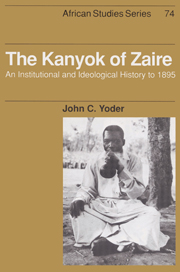Book contents
- Frontmatter
- Contents
- List of maps and figures
- Acknowledgments
- Abbreviations
- Chronology
- Introduction
- 1 Wood and wine, gardens and game
- 2 Stratification, symbols, and spirits
- 3 New legends for new leaders
- 4 Serpents and lightning
- 5 Dances, moats, and myths
- 6 Combat, classes, titles, and trade
- 7 Schisms and slaves, ghosts and guns
- 8 Assassinations, alliances, and ambushes
- APPENDIX: Methodology
- Notes
- Bibliography
- Index
- Titles in the series
2 - Stratification, symbols, and spirits
Early matrilineal society in the Luilu valley
Published online by Cambridge University Press: 29 September 2009
- Frontmatter
- Contents
- List of maps and figures
- Acknowledgments
- Abbreviations
- Chronology
- Introduction
- 1 Wood and wine, gardens and game
- 2 Stratification, symbols, and spirits
- 3 New legends for new leaders
- 4 Serpents and lightning
- 5 Dances, moats, and myths
- 6 Combat, classes, titles, and trade
- 7 Schisms and slaves, ghosts and guns
- 8 Assassinations, alliances, and ambushes
- APPENDIX: Methodology
- Notes
- Bibliography
- Index
- Titles in the series
Summary
The Kanyok believe they inherited their land or rivers, forests and savannas from the distant, immigrant ancestors described in their oral traditions. While most tales of heroic migrations reflect economic, political, social, and linguistic transformations of relatively stationary populations and do not recall actual geographical movements, the Kanyok are indebted to the earliest Bantu people who settled the southern savanna. For besides the land, the Kanyok and their neighbors inherited basic cultural concepts and practices from the men and women who entered the territory many hundreds of years ago. While recent borrowing is responsible for some of the cultural similarity evident across the region, ancient concepts about social stratification, symbolic representation, and spiritual forces are also part of the common savanna legacy which has existed for many centuries.
Emergence of the Kanyok as a distinct ethnic group
The Kanyok are but one of the hunting, gathering, fishing, and cultivating Bantu peoples who expanded and consolidated their territorial claims over the southern savanna during the last several millennia. Although most physical clues about the Bantu peoples from before 1000 BC have either been lost or not yet uncovered, linguistic evidence suggests that by approximately 1000 BC, the ancestors of the Ruund (or Lunda), Pende, and Cokwe groups now settled in northern Angola, south central Zaire, and northwestern Zambia were no longer closely associated with the predecessors of the Luba and Luba-related peoples, including the Kanyok, who now live to the east and north. After another thousand years, by perhaps AD 1, the Cokwe and Ruund forebears had separated into two distinct groups while the Luba, Tabwa, Bemba, and Lamba ancestors no longer maintained enough contact among themselves to preserve linguistic uniformity.
- Type
- Chapter
- Information
- The Kanyok of ZaireAn Institutional and Ideological History to 1895, pp. 12 - 28Publisher: Cambridge University PressPrint publication year: 1992



